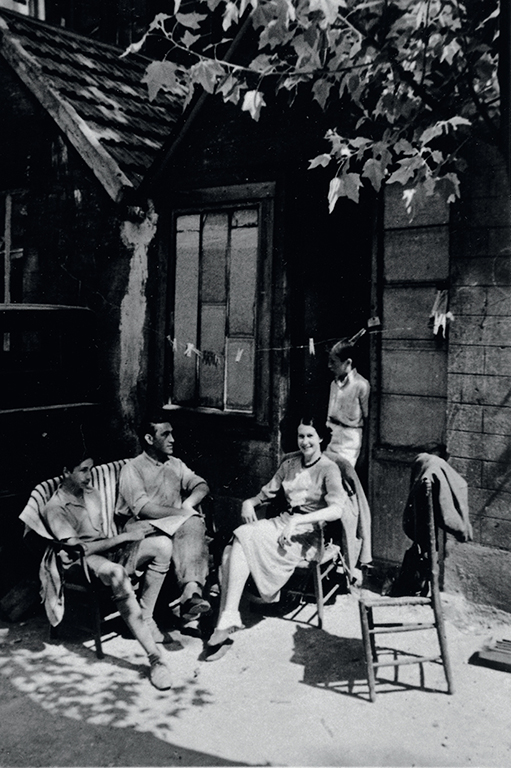Zelman UTKES
January 4, 2019Abraham WEINBAUM
January 4, 2019Lazare VOLOVICK
KREMENTCHUG (UKRAINE) 1902 – PARIS 1977
Lazare Volovick was the youngest in a family of seven. His father worked as a traveling salesman, and introduced his four sons to painting. In 1917, He enrolled in the School of Fine Arts in Kharkov and that of Kiev one year later. In 1920, he and his friend Kostia Terechkovitch decided to move to Paris. The two friends were penniless and hid in the hold of a cargo ship that took them to Constantinople. Volovick stayed in Turkey for a year, where he drew sketches in the street in order to earn his living. Volovick eventually arrived in Paris in 1921. He was poor and did not know anyone. The only indication he had on where to go was “the cafés in Montparnasse.” At La Rotonde, he met the sculptor Baidaroff-Poliakoff. He spent his first nights in Paris at the latter’s place. In 1922, he spent time at the Académie de la Grande Chaumiere , where he posed as a model for sculptors.
In 1923, he moved into La Ruche, where he stayed until the war. His studio was next to Krémegne’s, Kikoine’s, and Jacque Chapiro’s from 1925. Between 1923 and 1925, he traveled through France with the sculptor Nachmann Granowsky. They visited Corsica and the south of France and met the writer Colette. From 1927, numerous exhibitions and balls were taking place. Volovick and other painters in Montparnasse produced the décor of the Bal Bullier. In 1930, he visited Spain, discovered the Prado museum and met his future wife, the dancer Lya Grjebina. He accompanied her on her tours. Following a trip to Brittany, Volovick and his wife left Paris for New York for six months. They later stayed in London before returning to Paris. At that time, they met friends at Le Dôme or at La Coupole almost every day, including Ilya Ehrenburg and his wife, as well as the painters Naiditch, Robert Pikelny, and Jean Pougny. After the war, they preferred to go to Le Select bar.
In 1939, Volovick was at Le Touquet when the war broke out. During the roundups, he hid at his mother-in-law’s in Boulogne-Billancourt. As he could not paint oil paintings, he worked with pastels. In 1944, he returned to Montparnasse and settled at 11 rue Jules Chaplain. His studio at La Ruche had been occupied during the war and all of his works had been destroyed or plundered by the Nazis. In 1946, Volovick worked at the studio of his friend Vladimir Naiditch, at 51 boulevard Saint-Jacques, where he painted a series of nudes and portraits. He traveled to Venice several times in the postwar years.
Stories of Jewish Artists of the School of Paris 1905-1939
FRENCH-ENGLISH
Capitale des arts, le Paris des années 1905-1939 attire les artistes du monde entier. De cette période de foisonnement, un terme est resté, celui d'Ecole de Paris, qui recouvre une grande diversité d'expression artistique. Dans ce brassage dont Montparnasse est le creuset, un groupe se distingue : celui des artistes juifs venus de Russie, de Pologne et d'Europe centrale. Si leurs styles sont variés, un destin commun les rassemble : ils fuient l'antisémitisme de leur pays d'origine. Certains ont connu la célébrité dès les années 1920, tels Soutine, Lipchitz ou Chagall. D'autres n'ont pas eu le temps ou la chance d'y accéder. Près de la moitié a péri dans les camps de concentration nazis.
From 1905 to 1939, Paris attracted artists from all over the globe as the capital of the art world. This period of artistic proliferation became known as the School of Paris, and includes a great diversity of artistic expression. Within the teeming art world centred on Montparnasse, one group set itself apart: Jewish artists from Russia, Poland, and Central Europe. Although their styles were diverse, they shared the common fate of fleeing anti-Semitic persecutions in their home countries. Some became famous in the 1920s, such as Soutine, Lipchitz, and Chagall, while others did not have the time or the luck to gain renown. Nearly half of these artists died in Nazi concentration camps.






